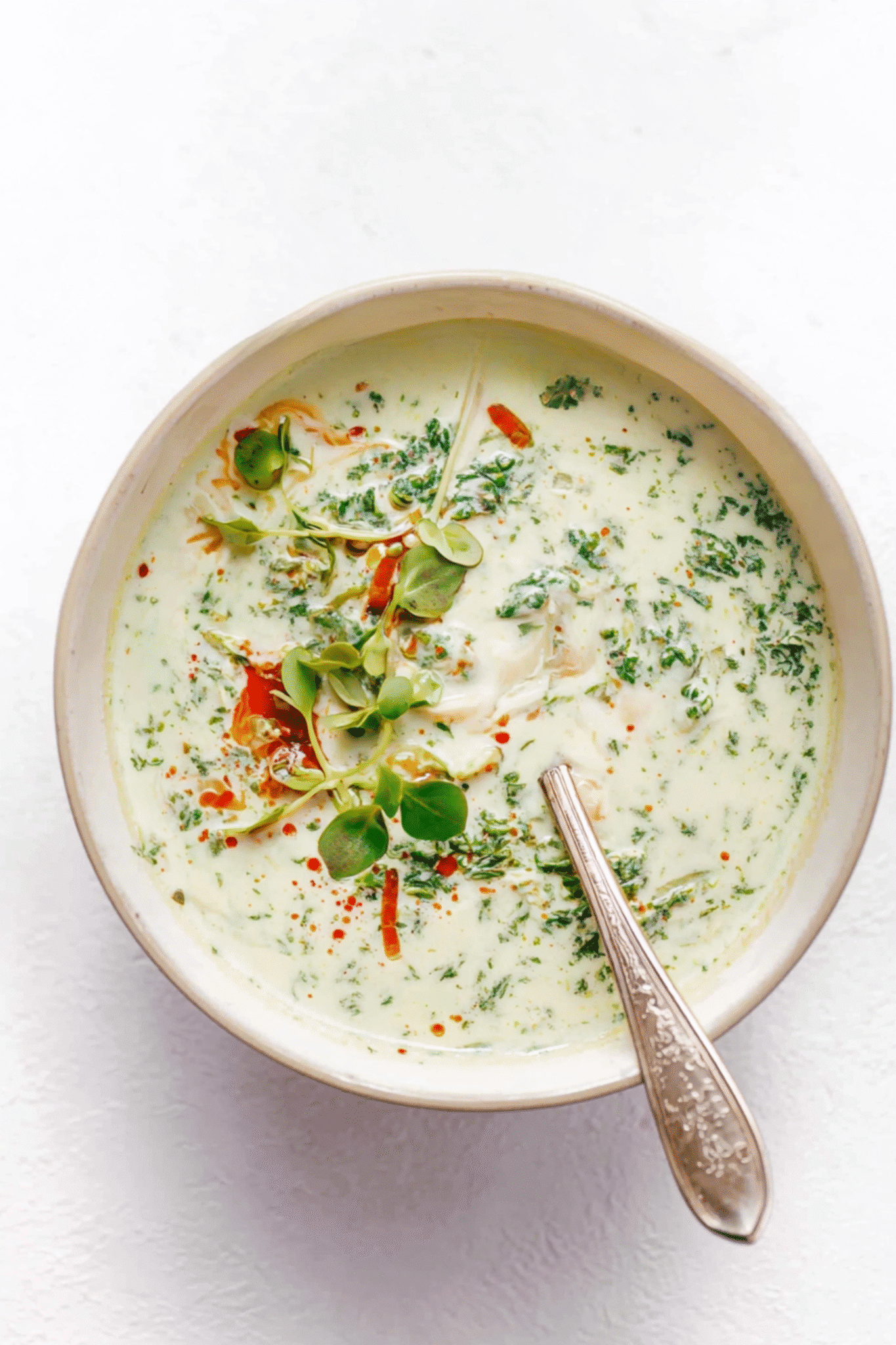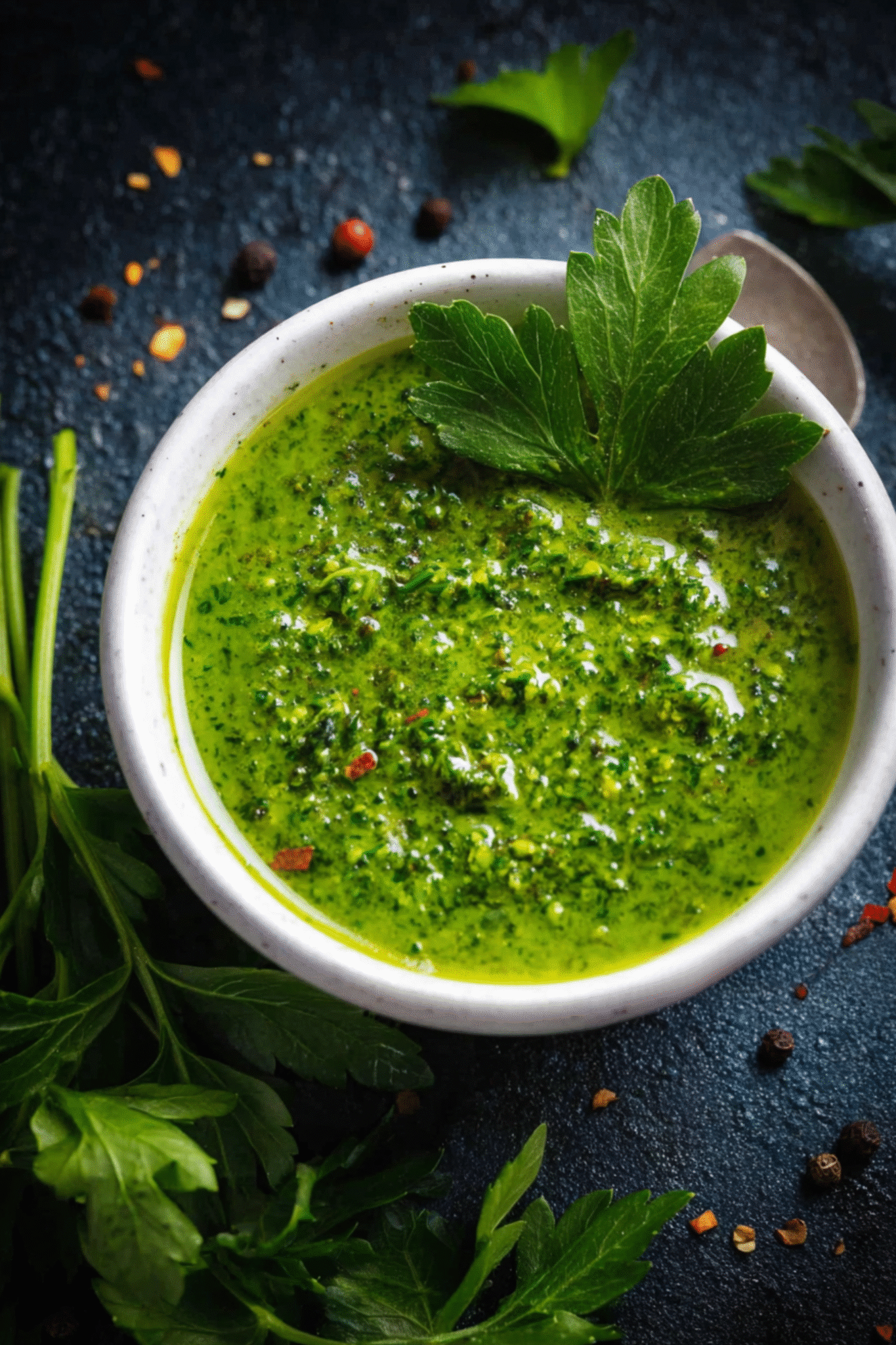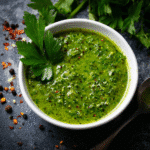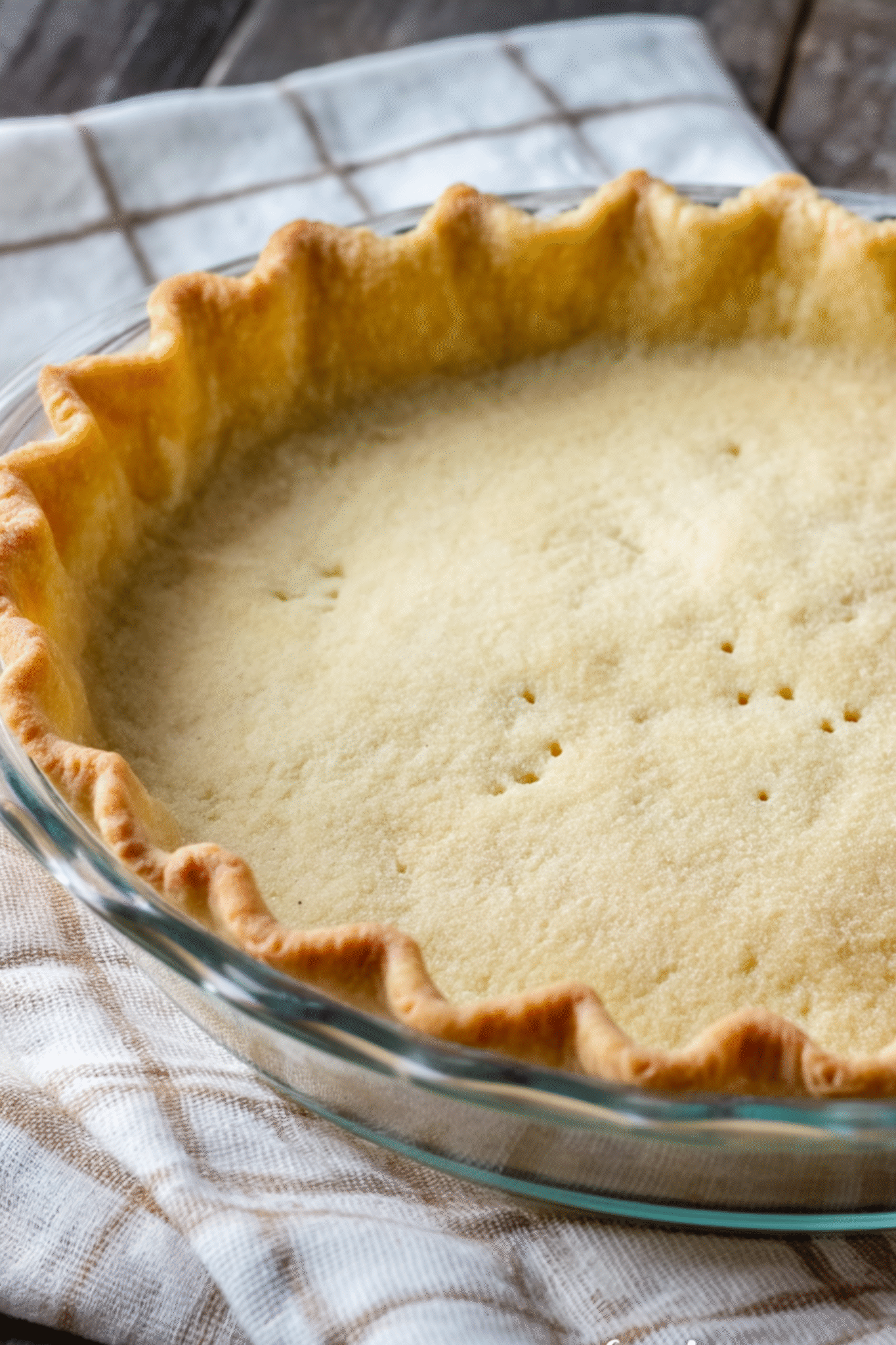There’s something wildly satisfying about a sauce that can turn a simple grilled steak or roasted veggie bowl into something spectacular. That’s exactly what cilantro chimichurri does. This vibrant green condiment, inspired by the classic Argentinian chimichurri, adds a citrusy, herby zing to just about anything. Whether you’re spooning it over smoky meats, stirring it into grain bowls, or using it as a marinade, it’s the kind of bold, garlicky magic every home cook should know.
In this article, we’ll walk through my personal connection to the dish, tips for making it your own, flavor pairings, and storage hacks to keep it fresh.

Table of Contents
The Story Behind My Cilantro Chimichurri
Why I Fell in Love with Cilantro Chimichurri
Growing up in Naples, we didn’t make chimichurri—but we understood the joy of sauces that brought food to life. When I moved to New York, I tasted chimichurri for the first time at an Argentinian popup. But the real magic happened later in my own kitchen. I was prepping dinner for friends—some grilled chicken, roasted sweet potatoes, and a beautiful cote de boeuf rib steak.
I realized I was out of parsley, so I grabbed cilantro instead. And wow. That accidental swap created a cilantro chimichurri that was fresh, a little grassy, with just the right punch. It reminded me of how my mother always said, “Ivana, you have a delicious hand—you know when to break the rules.”
I started serving it with everything—from Mexican shredded beef to roasted cauliflower. It even pairs beautifully with lighter dishes like this shopska salad when you want to add something bold and herbal.
What Makes This Chimichurri Different
Traditional chimichurri uses parsley, but cilantro chimichurri adds another layer. It’s slightly citrusy and more fragrant, perfect for those who love bold herbs. My version is simple—just fresh cilantro (or a mix of cilantro and parsley), garlic, white vinegar, olive oil, oregano, and chili flakes. That’s it. No food processor, no fuss. Just chop, mix, and enjoy.
This sauce isn’t just about dipping or drizzling. It’s the kind of flavor booster that transforms anything you spoon it over. For instance, try it with grilled meats like this instant pot Mexican shredded beef or stir it into a cottage cheese bowl for a high-protein twist.
Variations & Flavor Pairings for Cilantro Chimichurri
How to Make Cilantro Chimichurri Your Own
One of the best things about cilantro chimichurri is its flexibility. The base ingredients—cilantro, garlic, vinegar, and olive oil—are non-negotiable for me, but beyond that, you can easily adapt it based on what you have on hand or what you’re cooking.
No fresh oregano? Use a pinch of dried or swap in fresh thyme. Want it spicier? Add more chili flakes or a bit of jalapeño. You can even mellow it out with a few tablespoons of flat-leaf parsley, which helps balance the assertiveness of cilantro. I sometimes toss in a squeeze of lemon juice for extra brightness, especially when I’m pairing it with seafood.
If you’re meal-prepping or entertaining, cilantro chimichurri doubles as a fantastic marinade. Just spoon it over steak, chicken, or shrimp and let it sit for 30 minutes before cooking. It adds punch without overpowering the main dish.

Best Ways to Serve Cilantro Chimichurri
This sauce works like a charm with nearly everything. The classic pairing is steak, and if you’re cooking a big cut like cote de boeuf rib steak, you’ll want that herby kick on the side. But cilantro chimichurri is also a game-changer with roasted veggies, fried eggs, and even grilled tofu.
Looking for a light, satisfying combo? Drizzle it over a grain bowl or use it in place of dressing on a simple tomato salad. It also shines in sandwiches or wraps. For a creamy twist, stir it into low carb mayonnaise or even mix it with easy keto mayonnaise to make a zesty spread for burgers and veggie patties.
Here’s a quick reference table for ideal pairings:
| Dish | Why It Works |
|---|---|
| Grilled Ribeye or Cote de Boeuf | Cilantro adds brightness to balance the richness |
| Roasted Cauliflower or Zucchini | Herbaceous notes enhance earthy flavors |
| Shrimp or White Fish | Cilantro complements seafood’s sweetness |
| Eggs or Grain Bowls | Adds freshness and acid to creamy or neutral foods |
All About Ingredients & Chimichurri FAQs
What Herbs Go Into Chimichurri?
The classic herb in traditional chimichurri is parsley. Flat-leaf parsley is preferred for its clean, slightly peppery flavor. But in cilantro chimichurri, cilantro takes center stage. It brings brightness and a citrusy edge that’s especially great for Latin-inspired dishes.
You can also add fresh oregano—this is another traditional element that adds earthiness and depth. If fresh oregano isn’t available, dried works too (just use half the amount). While some modern takes use mint or even basil, I recommend sticking with the cilantro + oregano combo for that authentic kick.
For a deeper dive into green sauces, check out how we make basil chimichurri—a unique spin worth trying alongside grilled vegetables.

What Is Cilantro Chimichurri, Exactly?
Think of cilantro chimichurri as the bold cousin of the original. It’s a loose, oil-based sauce made with fresh herbs, garlic, vinegar, and oil. The texture is rustic, not blended—this lets each ingredient shine. The cilantro gives it a distinctive edge, making it stand out from its parsley-based sibling.
The best part? It comes together in minutes and stores beautifully in the fridge. Unlike cream-based sauces, it keeps its zing for days and even improves in flavor after resting overnight.
Wondering if you can swap parsley for cilantro in a traditional chimichurri recipe? Absolutely—you’ll just get a different, brighter profile. In fact, many Latin American families already do this depending on what’s on hand. I love using this version in sandwiches, tacos, or even as a dip with seared steak and a side of roasted tomato garlic soup.
Prep, Storage & Serving Tips
How to Store Cilantro Chimichurri (And Make It Last)
Cilantro chimichurri keeps surprisingly well, especially when made with high-quality olive oil and stored properly. The vinegar acts as a natural preservative, keeping the herbs vibrant for several days. After mixing, transfer the chimichurri into an airtight jar and store it in the fridge. It will stay fresh for up to 5 days.
Before serving, bring it to room temperature. Olive oil solidifies when cold, so a quick stir or a few minutes on the counter brings back its beautiful texture.
Want it to last longer? Cover the surface of the chimichurri with a thin layer of olive oil before sealing the jar. This extra barrier prevents oxidation. You can also freeze it in silicone ice cube trays—perfect for tossing into weeknight sautés or spreading on grilled veggies. Just thaw and stir!
Quick Tips for Serving with Flair
Here’s how I serve cilantro chimichurri in ways that feel fresh and a little unexpected:
- Drizzled over steak (especially thick cuts like cote de boeuf)
- As a dip for roasted cauliflower or spooned onto a warm grain bowl
- Swirled into mayo for an herby sandwich spread or burger topping (see this easy keto mayonnaise)
- With breakfast eggs, especially alongside sautéed spinach or roasted sweet potatoes
It also makes an excellent base for salad dressing. Just whisk it with a little more vinegar and olive oil, and you’ve got a dressing that livens up anything from greens to grilled corn.
FAQs About Cilantro Chimichurri
Can you use cilantro instead of parsley in chimichurri?
Yes, you can use cilantro instead of parsley, and that’s exactly how cilantro chimichurri was born. The swap adds a citrusy brightness and a more vibrant herbal flavor, making it a great twist on the traditional version.
What is cilantro chimichurri?
It’s a version of chimichurri made with cilantro instead of (or alongside) parsley. The result is fresher and more aromatic.
What herbs go in chimichurri?
The key herbs in cilantro chimichurri are fresh cilantro and oregano. Some recipes also include flat-leaf parsley for balance. These herbs combine to create the sauce’s signature punchy, aromatic profile.
What is chimichurri made of?
Fresh herbs, garlic, vinegar, olive oil, chili flakes, salt, and black pepper. Simple, bold, and beautiful.
Conclusion
Cilantro chimichurri is one of those sauces that never fails to bring a dish to life. Bold, bright, and ridiculously easy to make, it’s the kind of recipe that earns a permanent place in your weekly rotation. Whether you’re drizzling it over grilled meats, tossing it into veggie bowls, or marinating proteins, its zesty, herbaceous bite will never let you down.
If this recipe added something flavorful to your table, I’d love for you to join me beyond the blog. You can follow me on Facebook and Pinterest where I share more real-life kitchen stories, cozy recipes, and fresh ideas from my New York City kitchen. Let’s keep cooking with love—and with a delicious hand.
Print
Cilantro Chimichurri
- Total Time: 5 min
- Yield: 10 servings 1x
Description
This easy cilantro chimichurri recipe is zesty, fresh, and bursting with bold flavor. Perfect for grilled meats, roasted vegetables, or grain bowls.
Ingredients
1 cup (30g) cilantro or parsley or mix of both
1 tablespoon fresh oregano or ½ tsp dried
2 cloves garlic
¼ cup (60g) extra-virgin olive oil
2 tablespoons (30g) white vinegar
Pinch chili flakes (optional)
Salt flakes and black pepper to taste
Instructions
1. Finely chop the cilantro, oregano and garlic.
2. Combine with remaining ingredients in a small bowl.
3. Season with salt and black pepper to taste.
4. Serve immediately or refrigerate for up to 5 days.
Notes
Use as a marinade, topping, or dressing.
Add parsley for a milder herb profile.
Store with a layer of olive oil to preserve freshness.
- Prep Time: 5 min
- Cook Time: 0 min
- Category: Sauces & Dips
- Method: No-Cook
- Cuisine: Latin American
Nutrition
- Serving Size: 1 tbsp
- Calories: 75
- Sugar: 1g
- Sodium: 6mg
- Fat: 8g
- Saturated Fat: 1g
- Unsaturated Fat: 7g
- Trans Fat: 0g
- Carbohydrates: 1g
- Fiber: 1g
- Protein: 1g
- Cholesterol: 0mg
Keywords: cilantro chimichurri, sauce, marinade, herb sauce



